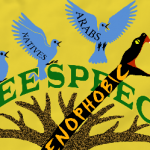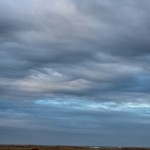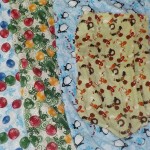I was raised in a household that was Pentecostal Christian (an Evangelical form of Christianity), and I grew pretty depressed as I was taught that I was born broken, and that I needed to get in good with Jesus in order to go to heaven, otherwise you are hell bound. So my entire youth was focused on being a good Christian and trying to reach others so that they wouldn’t end up in Hell either. Even though I was a dedicated Christian in my youth, I always enjoyed Nature. Going into the woods was a place of refuge and just being myself without the constant fear of being judged for doing something wrong. I loved learning about the natural world and how it functioned, trying to understand how I could best fit into it all.
It wasn’t until I moved away for college to study Wildlife Conservation did I start really thinking about my beliefs. One of the first things that I did when I moved was find the nearest Pentecostal Church and attended it. But over time I realized that most of what was taught in Christianity I didn’t agree with. My studies in how Nature works didn’t line up with what was said either. There was a fundamental denial in Christianity about our Natural History, and there was an undercurrent of male superiority that irked me. During this time away from home I also had the opportunity to learn about other beliefs and found that I tended to agree with some of these other beliefs more than what I was raised with.

One day it hit me – I no longer believe that there is a God, I no longer believe Christianity. I just couldn’t. It didn’t make any sense. Having everything I thought was foundational about my place in the world fall out from under me left me feeling the need to grasp at the closest thing that I could feel was solid ground. That ended up being Paganism. It was a safe haven to explore myself to find where I stood in this crazy world, being very accepting of differing worldviews and open to this sort of exploration.
Symbols In Image:
Abrahamic Symbols – Jewish Star of David, Christian Cross, and Islamic Star & Crescent.
Pagan Symbols – (On Tree, Top to Bottom) Triple Moon, Horned God, and Pentagram; The Stag for the “horned god”, Earth mound with Earth Goddess, White Rabbit wearing Awen, Log in front of anthropomorphized goat has an inverted Pentacle, The stones to the right of that is the Triskelion, and to the right of that the Year Wheel, The shield has the Valknut, the stone beside it displays the Triquetra, The alter with the druid sacrificing an apple is the Reformed Druids of North America symbol. The Tree to the right of the meditating person is The Tree of Life.
Aboriginal Symbols – the hoop hanging from the Tree of Life is the Medicine Wheel. The stone to the left of the tree is the Anishinaabe Thunderbird.
Non-theistic Symbols – The symbol in the earth to the right of the Thunderbird stone is the Atheist symbol. The stone being stood on is the Ehoah Sigil. The Image in the sky is the Ehoah Star.
But most importantly to me was that Nature was part of their practice, not separate or lesser like how Christianity saw it. Being someone who always felt like they were a part of Nature, not separate or better than it, this was a good fit. From there there are a lot of options for those who want to dedicate themselves to a more specific worldview like Polytheism or Animism. As I was exploring my own thoughts I explored each of these Pagan worldviews. Out of all the Pagan paths Druidism appealed most to me.
The Druid group that I ended up finding most in common with were the Reformed Druids of North America (RDNA). It was the most open to exploration while at the same time was nature-based in practice. They have an easy going attitude with much banter, not being afraid to make fun of themselves, and all you needed to do to join was agree with their Two Basic Tenets:
‘One of the many ways in which the object of Man’s search for religious truth can be found is through Nature: The Earth Mother’
‘Nature, being one of the primary concerns in Man’s life and struggle,
and being one of the objects of creation, is important to Man’s Spiritual quests’
If you wanted to leave, you just did – no hard feelings.
It was around this time did I look for and find a Pagan group in my local area to join and participate in. What I found was a Pagan Association which was a mixed group that was made up mostly of Wiccans. I ended up being the only self described Druid in the group. Being a mixed group had meant that there was a constant search for meeting everyone’s needs and there were a lot of creative discussions to this end. One such creative discussion was on how the group followed the Year Wheel, and how the common celebrations associated with it were out of sync with the reality of our climate in northern Ontario, Canada.
Having been baffled by our current modern civil calendar to begin with, I personally set out to explore a solution. This resulted in me inventing a calendar for the northern hemisphere that oriented around the solar-earth events (equinoxes and solistices), with different months, and a six day week, taking a year to develop. Through that year I also had developed more upon my personal practice as a druid. So by the time I presented my calendar to my group, they had found that working with the current modern civil calendar worked best for the group as it wasn’t favoring any one practice over another, which I thought suited the group’s purpose well. But having made a calendar that actually worked, I wanted to do something with it. It was then that a friend pointed out how it worked well and that they liked the tradition I was developing. It was at that moment that I realized that was what I was actually doing. The way I’ve been directing my personal practice was going in a different direction from any practice available at the time. I was creating an off-shoot from Reformed Druidism.
How this tradition became an off-shoot was that the Two Basic Tenets were altered into Three Basic Tenets:
“Through Nature fulfillment can be found”
“Nature, being inseparable from humanity’s existence, is important in human pursuits”
“As humans are part of Nature it is important to ensure our connections within it are harmonious”
The reasoning was to simplify the core meaning of the original two tenets, reworded so that it became open to those who were non-theistic, and added the third to emphasize the point of the tradition and direction of practice (which is to work towards ensuring all our connections within Nature are harmonious, in everything we do and use; maintaining an awareness of and respect for our interconnections and creating a lifestyle that reflects this. Being a process that is continually improved upon with no end point). In addition to this it didn’t focus so much on the Celtic traditions, instead considering it one of many sources of inspiration. One of the reasons was that little is actually known of what the ancient druids did and so regardless we’d be doing something different anyway. Which made calling ourselves druids unsuitable so a new name was needed. While in my personal practice I had developed a meditation chant based on the sounds of breathing, being the vowels “a” (as in able), “o” (as in open), and “a” (as in apple), giving it the name Ehoah – as it sounded. The meaning attributed was “complete harmony within Nature”. Thus someone who followed this path would be seeking completely harmony within Nature, a Seeker of Ehoah, and be called a Saegoah (saeg being the root word for ‘seek’).
While venturing now as a Saegoah I was able to delve into learning the traditions of the native side of my ancestry which helped develop my personal path. But I was still uncertain of whether or not I believed in the existence of the supernatural. I still wanted to figure that out for myself, and an opportunity came from a friend inviting me to a Yuwipi – a traditional Lakota healing ceremony wherein the healer would be wrapped in a blanket, tied up on a blanket alter, in complete darkness among the participants, and call on the spirits for healing for those present. I was told that if I doubted the supernatural, that this ceremony would lay those doubts to rest. So I went, eager to see if this were true. I became a helper and helped make the tobacco ties for the ceremony and met the healer and his family before the ceremony.
During the ceremony the healer called out to the spirits for aid and said that two children came to help. This is when you saw a blue light flicker and the drummers began to drum for the spirit, and that flickering blue light moved among us to bless and heal those present. I was elated that I finally had something to show that the supernatural existed. Then we heard wings beating, the healer said a speckled hawk came to help those who needed it, and the drums picked up again and we not only saw the flickering blue light, but heard the wing beats and felt its wings touch us in the darkness. The dancing had picked up fervor.
Before the ceremony we were told that we shouldn’t interfere with the spirits. But then I became curious and thought that if the spirits didn’t want to be touched then they would move away if I came closer, so I slowly reached my hand out to the flickering light and touched a very human hand holding a rawhide shaker. Feeling deflated I sat down – the person holding the shaker had poked me sharply with it, perhaps trying to express a displeased spirit. But since I had sat down the shaker ended up poking me in the face, then a hand had reached out to find where I was – this hand had a wing attached to it, then the wing was brushed over me and they moved on. It was then that I had remembered something from when I was studying luminescence and came across mechanoluminescence – that the blue flickering light I was seeing was a rawhide shaker filled with quartz, and that it was the quartz hitting each other that caused the blue light. I berated myself for not realizing it sooner the rest of the ceremony.
When the ceremony came to a close I still helped with providing the feast, and then kept myself busy with the dishes, not wanting any awkwardness. Those that were running the ceremony were huddled and speaking in hurried concerned tones. We had shared a ride to the place and now we had to ride back together. While on the way there there was active conversation, on the way back however it was awkward silence. Then the spouse of the healer had asked what I thought of the ceremony, and I quickly responded that “It was wild”. To that their child was responded, “see, she doesn’t know anything” and was quickly hushed. When we parted ways I genuinely wished them safe travels.
Upon arriving home I spoke with my spouse about what had happened and they had succinctly deduced that the ceremony was the native equivalent of a séance. And if you know anything about seances is that they were also ceremonies that were held to speak with spirits in complete darkness, and they were debunked by participants in ways similar to mine. So since then I found that I am unable to believe that there is any supernatural elements in this world and firmly found myself in Naturalism – “Any of several philosophical stances wherein all phenomena or hypotheses commonly labeled as supernatural are either false or not inherently different from natural phenomena or hypotheses.” And thus consider myself a Naturalist in both Naturalism and in the Study of Nature.
Having reached this philosophical point I ended up questioning whether the Pagan label suited me anymore. I remain firmly a student of Nature and my lifestyle still reflects this. But Pagan often came with the associations of magic, spirits, and deities – things I no longer have any association with. So for some time when asked what my beliefs were I would just say Naturalist, and if the person was keenly interested in a respectful way I’d mention being a Saegoah which cut to the chase of what I really believed and did. This in many ways helped in reaching an understanding without the baggage of misunderstandings of what Paganism is. Yet to many people, within and outside of Paganism, I remain a Pagan because my practice is so nature-based. I was later reminded how that was still true through the words of Emma Restall Orr, describing a pagan as someone who looks “to the landscape, the environment, the ecology of a place, nature herself, for guidance in every aspect of their lives.” And how these words are consistent with how history uses “pagan” to mean people of the countryside (from Latin paganus, civilian, country dweller, from pagus country district).
It was with this reminder of my paganism did I recall one line that I had came across in Druidism that resonates with me still, “I am first Beast, then Human.”
















